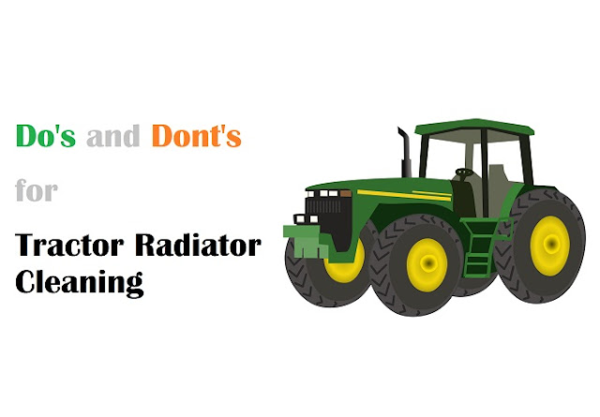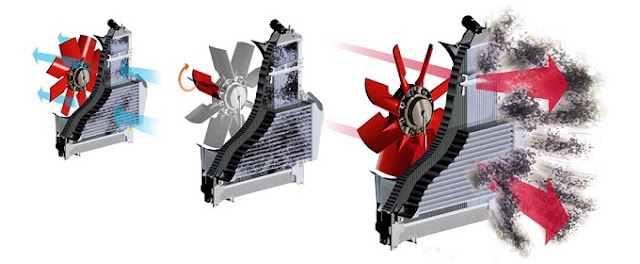The Dos and Don’ts for Tractor Radiator Cleaning

Taking some time every now and then to ensure the good working order of your farm vehicles and machinery is a must in modern farming. What with the ever-growing cost of maintenance that needs to be undertaken on a regular basis, one of the best things you can do to save time, money and stress when it comes to your yearly vehicle check-up is to take the matter into your own hands.
One of the more common issues around tractor maintenance when it comes to back-for-buck DIY savings is making sure you look after your radiators, and cleaning them on a regular basis. This guide will show you all of the best techniques and routines that will give you the ultimate radiator cleaning solution to save your hard-earned cash!
Modern tractors are a marvel of modern design and technology all rolled in one to give you the ultimate in farming utility and reliability, but like most farm machinery is used to their limits regularly. By keeping these stalwarts of modern farming in their best possible shape, a modern tractor can last many years of heavy use, thanks to their rugged design, but also the users’ proficiency in keeping them maintained.
Tractor Radiator Clogs and Maintenance
One of the most frequent issues farmers have when using their tractors is keeping the system cool and running smoothly. The radiator plays a huge role in maintaining the overall health of the vehicle, and with good maintenance, can ensure reliability in any weather conditions. Many radiators get stuck or clogged with dirt and dust which may lead to the failure of other components related to cooling, increasing the cost of repairs and maintenance down the line.
Many modern tractors contain multiple radiators to ensure the good working order of the engine, air conditioning as well as fuel efficiency and safety. Whilst many tractors have their own style of manufacture, in terms of where the radiator systems are located, most, it not all are often found at the front of the vehicle, and all contained in a single space with small gaps dividing the different types.
Radiator System Location and Uses
For example, many of the modern CAT tractors will contain at the front some form of protective gauze or grill to help the radiator system avoid larger objects, stones, dirt and general farm mud and soil, followed by a hydraulic oil cooler. This type of cooler is often a smaller unit that helps cool the oil used in the hydraulic system and function of the tractor itself. The next radiator is used for air conditioning, designed to keep the cab comfortably temperature regulated. After this we may find the fuel cooler which is designed to keep the fuel at a good working and safe temperature and lasty we will find the main engine cooling radiator.
Whilst these radiators may be found in a compact location, there are a number of ways in which we can clean and maintain them without having to disassemble the entire radiator system. Radiators work on a principal of transferring heat from one part of the system into another, thereby cooling the part by which the heat is drawn from. Any type of debris, be it dirt, mud or other flora may act as an insulating device and stop the heat transfer occurring. In simple terms, if a radiator becomes coated in mud or dirt, the efficiency by which the radiator can help cooling the system is dramatically reduced and may cause malfunction, damage or potentially destruction of a vehicles engine or sub systems.
Using Compressed Air
Ensuring that you can clean the radiator system in your tractor is a key factor in increasing the longevity of your vehicle. So what’s the best way to clean the radiator? Definitely not water! One may think that using a hose and water to clean off any debris will be a simple task, we often clean tyres and other vehicles quickly that way – but the introduction of water to a radiator will likely create mud, and mud is definitely one thing to avoid altogether.
Alternatively, one of the best ways to clean a radiator is via the use of compressed air. Many farmers will already have access to an air compressor, so this is one of the easiest and cheapest ways to keep your tractor running in all conditions. Once you have removed the hood of the tractor, there may be a few dirt and dust cover to remove, so ensure you have taken them off and exposed all of the radiators you intend to clean.
You may want to go over the radiators gently with a thick brush to knock off any debris that you will find stuck on, and depending on the amount of dirt and possibly dried mud, you may want to use something stiffer to remove the debris. Try to avoid a hard wire brush as this may cause a small amount of damage to the grill flaps themselves.
Once you have removed enough with a stiff brush, set your air compressor to a medium level and you can start to knock out all of the dust and dirt easily, aiming the compressors flow between the radiator blades to ensure a deep clean. Be careful where you are blowing the dust into, and try to ensure that the flow of dust and dirt travels away from any air intakes and rubber pipes just to be on the safe side.
Reversable Radiator Fans

One of the best ways to ensure a good coverage around and in-between the radiator blades or coils is to use a little extender pipe to ensure you can reach the parts that your compressor might not be able to reach. But there is actually one tractor radiator cleaning solution that will help you avoid all of the cleaning, repairs and maintenance that a regular radiator would cause: The cleanfix reversable fan.
As one of the best innovations in the agricultural industry, the cleanfix fan has proven its worth in even the dirtiest, dustiest environments any farmer will encounter. The reversable fans provide tractor engines with unparalleled cooling airflow, but being reversable they are able to stroll through the daily maintenance of removing dust and debris in a single sitting. This allows cleanfix reversable fans to keep your tractor moving with no stopping, no hassle and no maintenance. If you are after an all-in-one tractor radiator cleaning solution that will also help your efficiency grow, its time to throw in the gloves, and let the fan do all the work.
